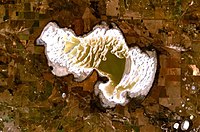
Photo from wikipedia
Plant photosynthesis and biomass production are closely associated traits but critical to unfavorable environmental constraints such as salinity and drought. The relationships among stress tolerance, photosynthetic mechanisms, biomass and ethanol… Click to show full abstract
Plant photosynthesis and biomass production are closely associated traits but critical to unfavorable environmental constraints such as salinity and drought. The relationships among stress tolerance, photosynthetic mechanisms, biomass and ethanol yield were assessed in Phragmites karka. The growth parameters, leaf gas exchange and chlorophyll fluorescence of P. karka were studied when irrigated with the control and 100 and 300 mM NaCl in a nutrient solution and water deficit conditions (drought, at 50% water holding capacity). The plant shoot fresh biomass was increased in the low NaCl concentration; however, it significantly declined in high salinity and drought. Interestingly the addition of low salinity increased the shoot biomass and ethanol yield. The number of tillers was increased at 100 mM NaCl in comparison to the control treatment. High salinity increased the photosynthetic performance, but there were no significant changes in drought-treated plants. The saturated irradiance (Is) for photosynthesis increased significantly in low salinity, but it declined (about 50%) in high salt-stressed and (about 20%) in drought-treated plants compared to the control. The rates of dark respiration (Rd) and compensation irradiance (Ic) were decreased significantly under all treatments of salinity and drought, with the exception of unchanged Rd values in the control and drought treatments. A-Ci curve analyses revealed a significant improvement in the Jmax, Vc, max, and triose-phosphate utilization (TPU) at lower salinity levels but decreased at 300 mM NaCl and drought treatments compared to the control. In the chlorophyll fluorescence parameters (Fv/Fm, maximum photochemical quantum yield of PSII, and Y(NO)), the non-photochemical yields were not affected under the salt and drought treatments, although an effective photochemical quantum yield (YII) and electron transport rate (ETR) were significantly enhanced in water deficit compared to control plants. P. karka regulates an efficient photosynthesis mechanism to grow in saline and arid areas and can therefore be used as a sustainable biofuel crop.
Journal Title: Plants
Year Published: 2022
Link to full text (if available)
Share on Social Media: Sign Up to like & get
recommendations!